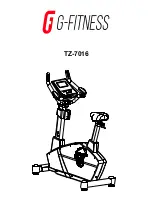
11
HOW TO USE THE PEDALS
To use the pedals (see the drawing on page 4),
insert your shoes into the toe cages and pull the ends
of the toe straps. To adjust the toe straps, press and
hold the tabs on the buckles, adjust the toe straps to
the desired position, and then release the tabs.
HOW TO ADJUST THE PEDALING RESISTANCE
To increase the resis-
tance of the pedals,
turn the resistance
knob clockwise;
to decrease the
resistance, turn the
resistance knob
counterclockwise.
To stop the flywheel, push the resistance knob
downward. The flywheel should quickly come to a
complete stop.
IMPORTANT: When the exercise bike is not in use,
tighten the resistance knob completely.
HOW TO LEVEL THE EXERCISE BIKE
If the exercise bike rocks slightly on your floor during
use, turn one or both of the leveling feet on the front or
rear stabilizer (see the drawing on page 4) until the
rocking motion is eliminated.
HOW TO MAINTAIN THE EXERCISE BIKE
Inspect and tighten all parts of the exercise bike regu-
larly. Replace any worn parts immediately.
To clean the exercise bike, use a damp cloth and a
small amount of mild detergent.
HOW TO ADJUST THE CHAIN
The exercise bike features a chain that must be kept
properly adjusted. If the chain causes excessive noise
or slips as you pedal, the chain should be adjusted.
To tighten the chain,
loosen, but do not
remove, the axle
nuts on both sides
of the flywheel. Pull
the flywheel forward
slightly. Make sure
that the flywheel is
straight and retighten
the axle nuts.
Resistance
Knob
Axle
Nut
Flywheel
FCC INFORMATION
This equipment has been tested and found to comply with the limits for a Class B digital device, pursuant to part
15 of the FCC Rules. These limits are designed to provide reasonable protection against harmful interference
in a residential installation. This equipment generates, uses, and can radiate radio frequency energy and, if not
installed and used in accordance with the instructions, may cause harmful interference to radio communications.
However, there is no guarantee that interference will not occur in a particular installation. If this equipment does
cause harmful interference to radio or television reception, which can be determined by turning the equipment off
and on, the user is encouraged to try to correct the interference by one or more of the following measures:
• Reorient or relocate the receiving antenna.
• Increase the separation between the equipment and the receiver.
• Connect the equipment into an outlet on a circuit different from that to which the receiver is connected.
• Consult the dealer or an experienced radio/TV technician for help.
WARNING: Per FCC rules, changes or modifications not expressly approved by ICON could void the
user’s authority to operate the equipment.
































